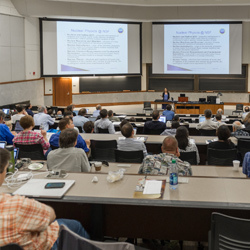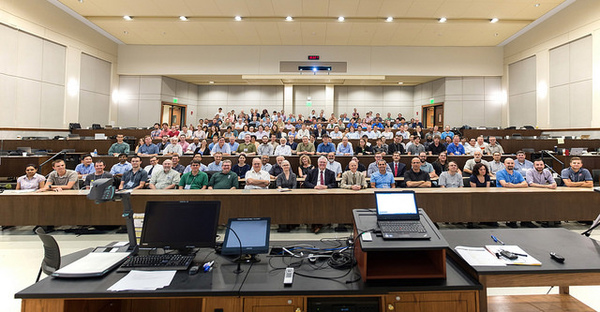

The University of Notre Dame hosted more than 230 experts at the 2016 Low Energy Community Meeting on Aug. 11-13 in the Jordan Hall of Science. The annual gathering, which started in 2011, sets priorities for research that help guide the Department of Energy and the National Science Foundation while providing opportunities for education and networking among researchers from universities and national laboratories. The event comes as the community prepares for the opening of the Facility for Rare Isotope Beams (FRIB) at Michigan State University, the highly-anticipated “FRIB Era.”
“It’s a very good opportunity for us to meet with other scientists,” said Maxime Brodeur, an assistant professor of physics at Notre Dame in the areas of applied medical and nuclear physics who was a lead organizer of the meeting. “You might learn new things from other colleagues. A lot of us give talks. You might learn something new from one of the groups. It’s a very good sharing opportunity.”
“The goal of these meetings is sort of twofold–one is to communicate and coordinate on what the vision is for the future of nuclear structure physics and nuclear astrophysics,” said Tim Hallman, associate director for nuclear physics in the Department of Energy Office of Science. “The other is to have real workshops to plan the details of things they would like to do. It’s a very good opportunity for our office to tune in to what the community has planned.”
The Notre Dame event included seven pre-meeting workshops on nuclear data, tracking detectors, ARUNA, ARUNA spectrographs, DAQ, SECAR, AGFA, and AIRIS, and 12 working group sessions as well as plenary talks on such topics as U.S facilities, education, and funding agencies. The meeting produced a list of priorities beginning with FRIB, which is expected to begin operation in two or three years.
“The meeting this year at Notre Dame was one of the best and most exciting yet,” said
Brad Sherrill, director of the National Superconducting Cyclotron Laboratory. “The University of Notre Dame was the perfect place to host the meeting given their outstanding facilities and highly respected nuclear science effort. The participants were uniformly glowing about the hospitality of the Notre Dame staff and how well-run the meeting was. We would be happy to come back every year.”
In addition to Brodeur, the organizing committee was comprised of Ani Aprahamian of Notre Dame, Baha Balantekin of the University of Wisconsin, Alexandra Gade of Michigan State, Paul Fallon of the Lawrence Berkeley National Laboratory, Krzysztof Rykaczewski of the Oak Ridge National Laboratory, Hendrik Schatz of Michigan State and JINA, Michael Thoennessen of FRIB, Alan Wuosmaa of the University of Connecticut, and Sherry Yennello of Texas A&M.